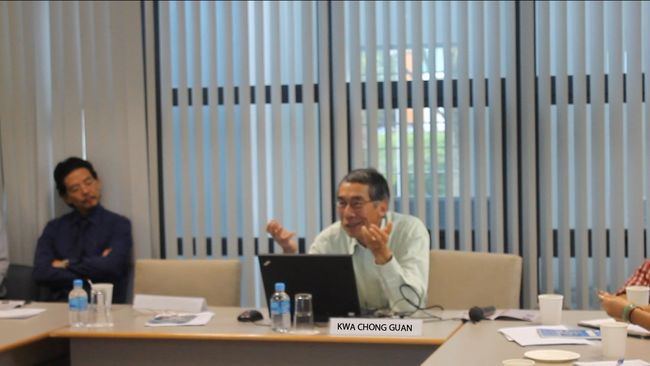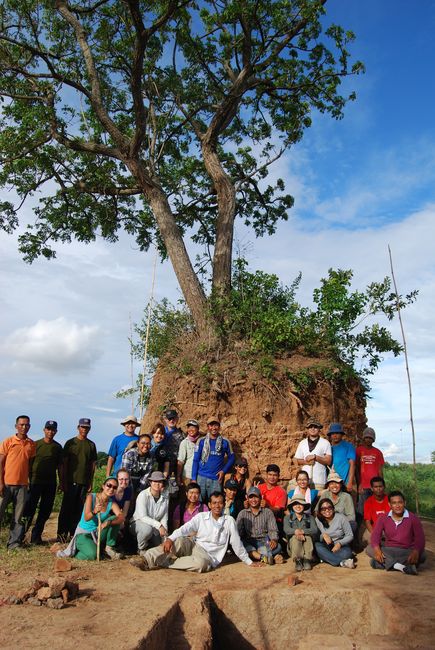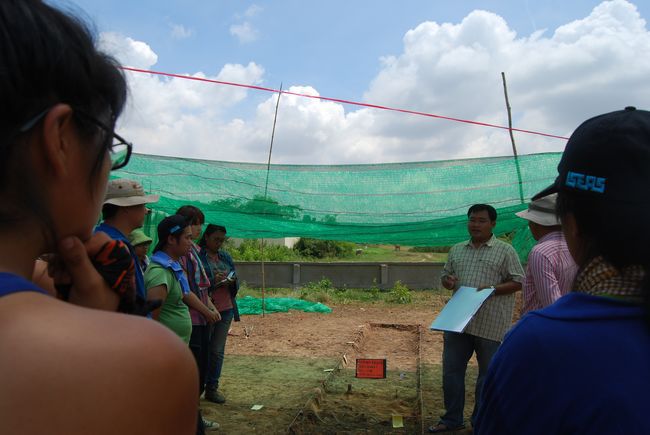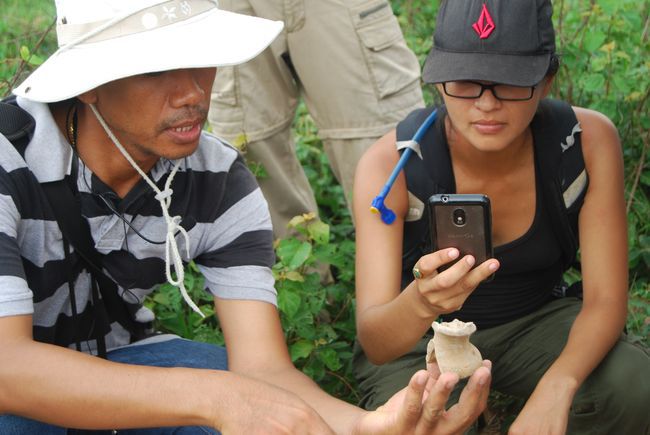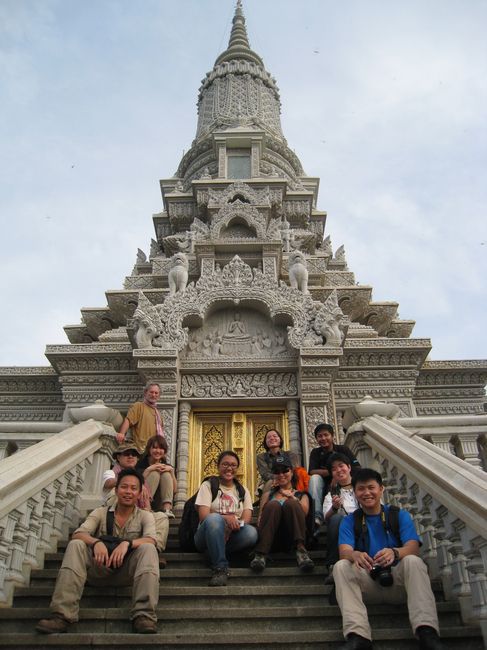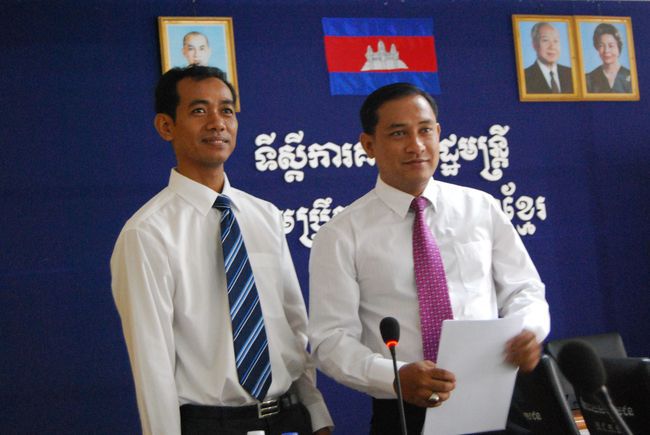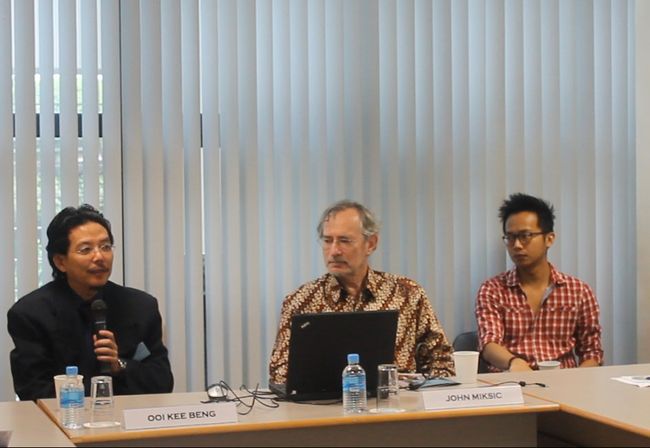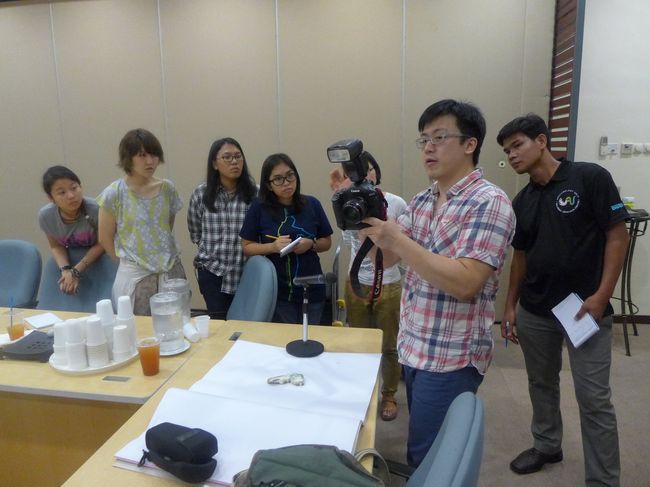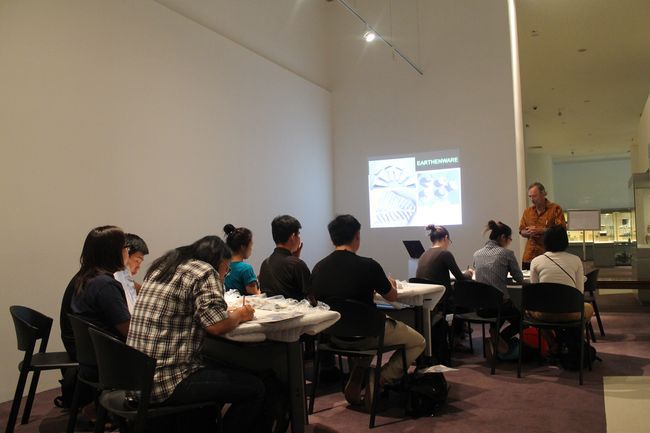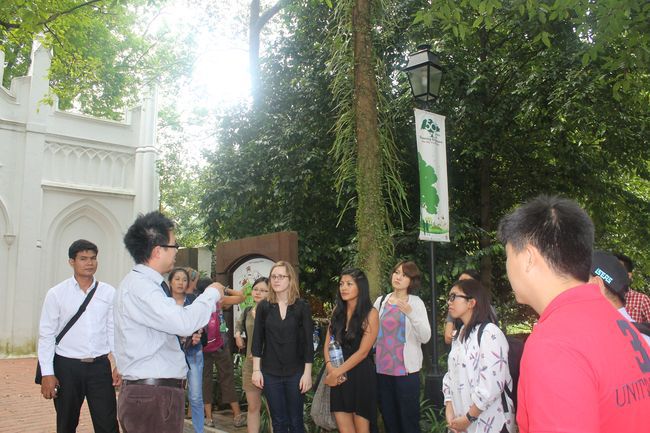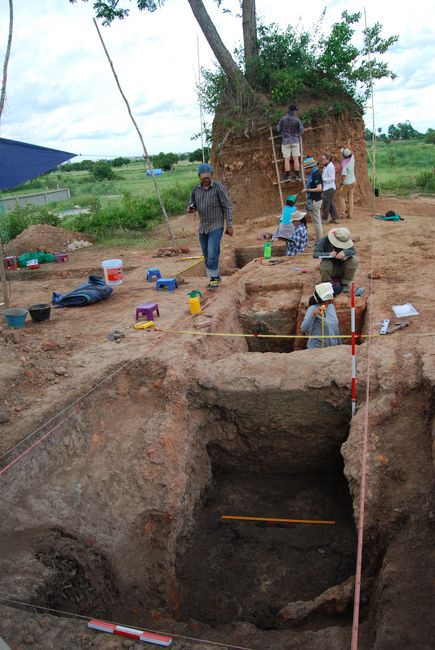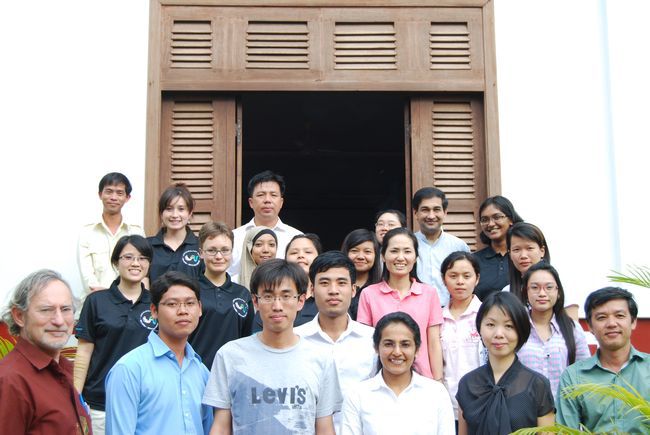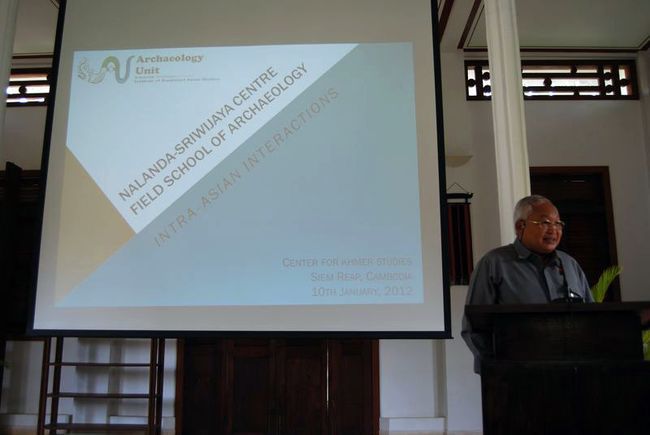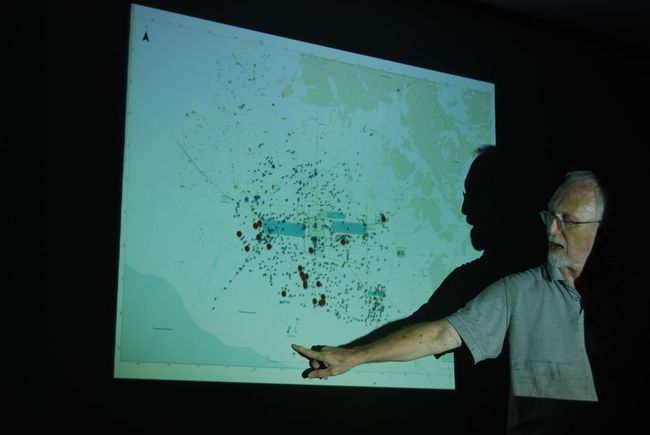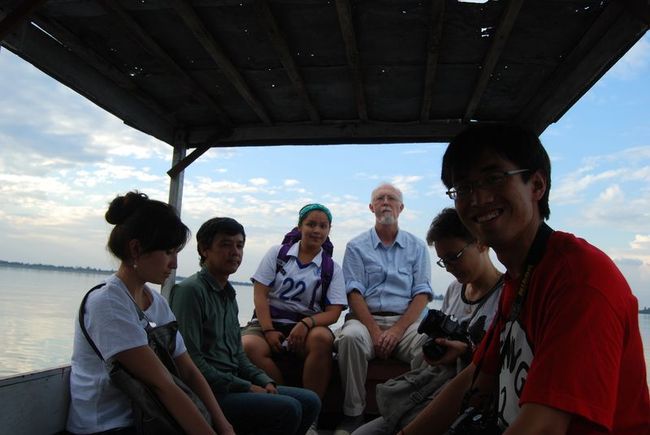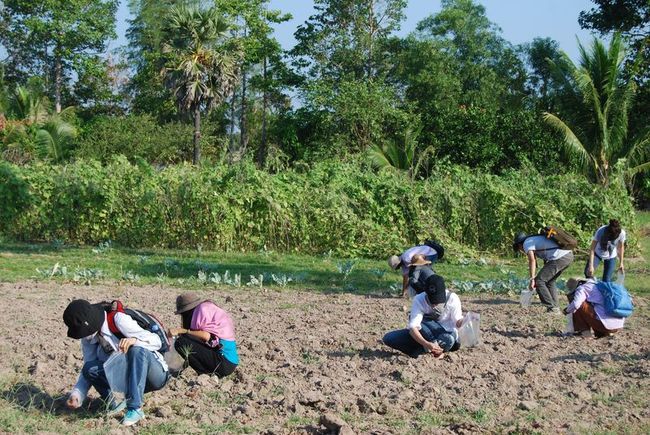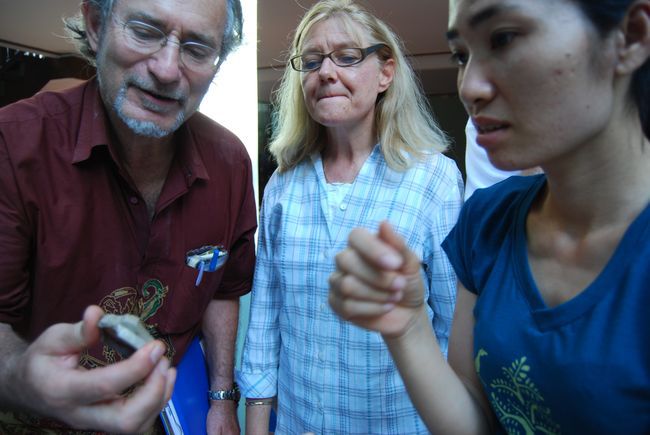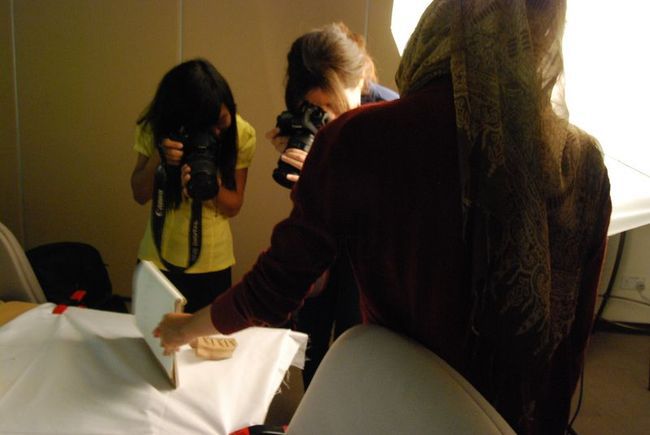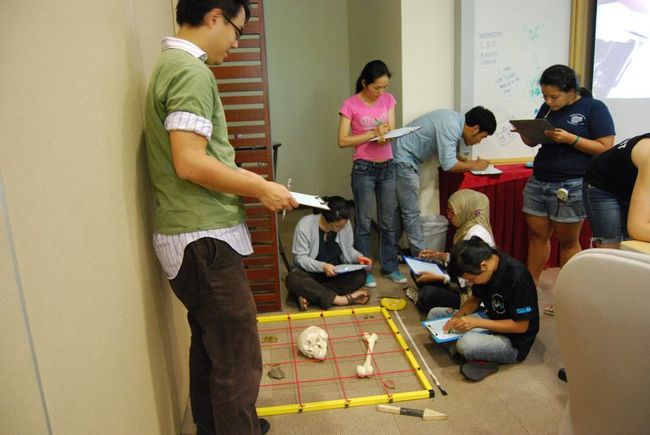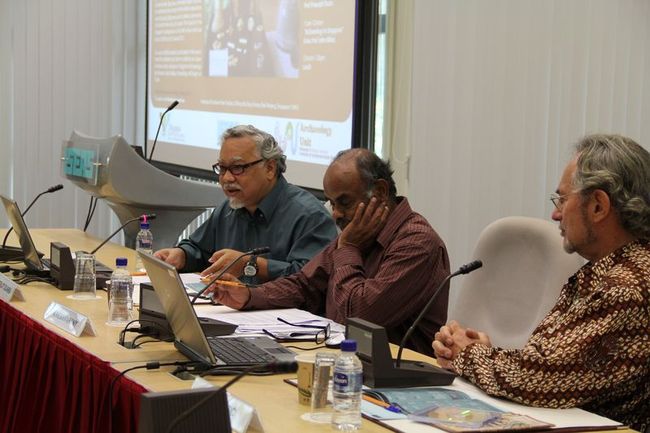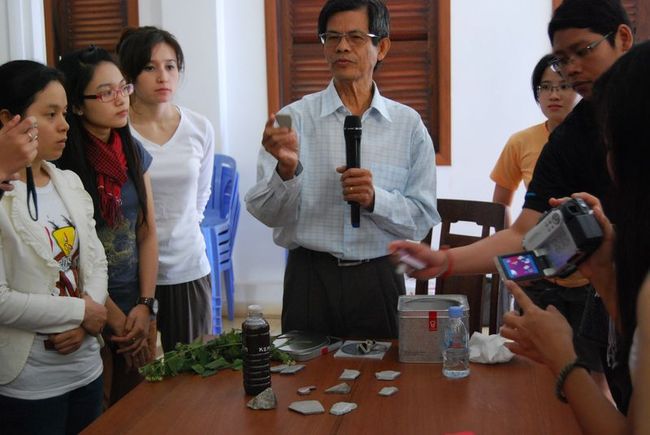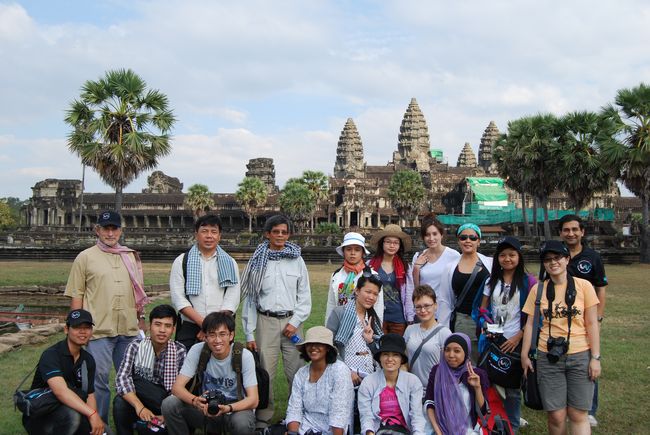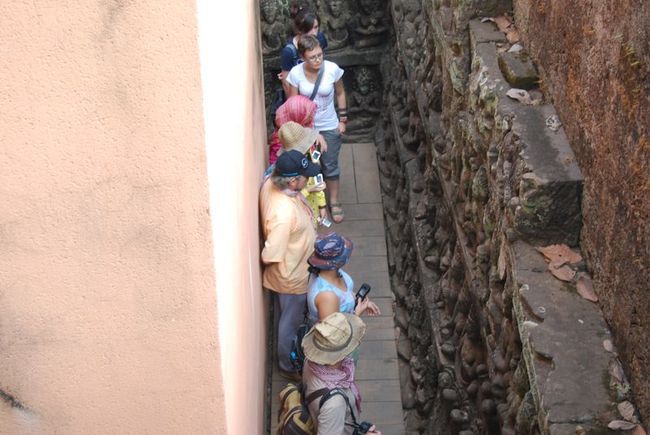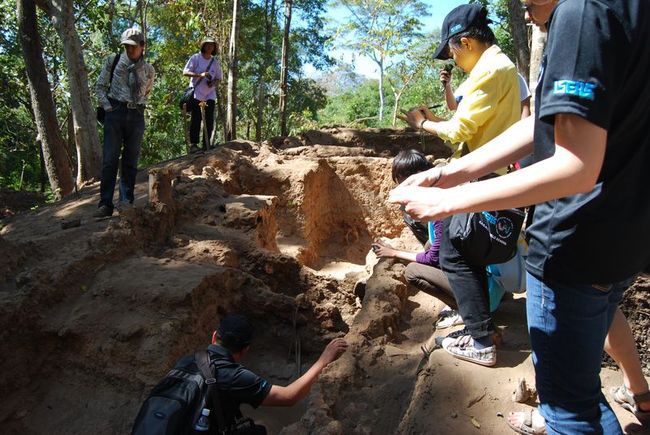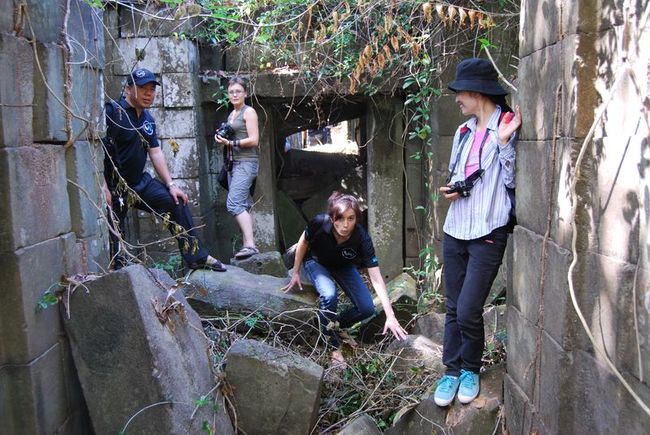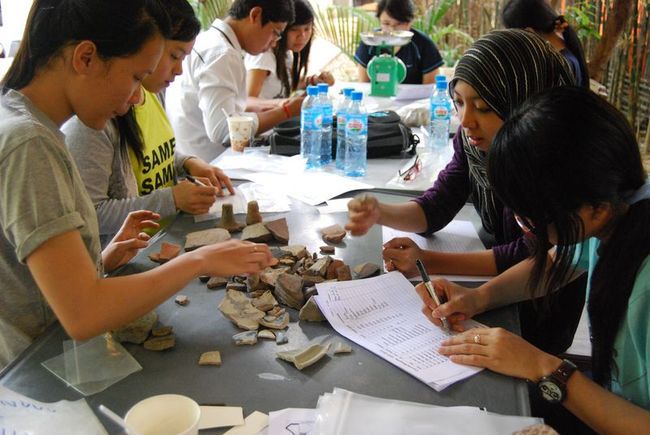Focus: Premodern Java
23 July – 2 August 2016
Trawas, East Java (Indonesia)
CALL FOR APPLICANTS
This pioneering Summer Programme will focus on premodern Javanese Art History, in both its local and translocal dimensions. It will cover from the Central Javanese ‘Hindu-Buddhist’ period to the late Majapahit and Early Islamic period (ca. 8th–early 17th century).
This Summer Programme is the result of a partnership between the Nalanda-Sriwijaya Centre at the ISEAS–Yusof Ishak Institute (Singapore), Universitas Surabaya (Indonesia), and SOAS’ Southeast Asian Art Academic Programme (SAAAP) at the Department of the History of Art and Archaeology, School of Arts (UK). It aims to promote the study of Southeast Asian Art History in the region and internationally.
The Summer Programme will be taught by a pool of ten Indonesian and European experts from different disciplinary backgrounds. It will showcase the state-of-the-art research on Javanese Art History and related aspects of culture, history, and religion. It will also introduce the participants to the basics of conservation techniques and current approaches to museology in a local and global context.
Who can apply?
To be eligible to apply for the 2016 NSC-ISEAS/SOAS Summer Programme, you must:
- be a full-time and advanced undergraduate (final year) or post-graduate student pursuing a full-time degree in Art History, Archaeology, Museology, History, or related fields; be a researcher, Museum curator, or civil officer active in one of the above fields (see FAQs).
- have a good command of English (English is the language of instruction).
Location
Held over ten days at Ubaya’s Integrated Outdoor Campus (IOC), the programme will be located at the foot of Mount Penanggungan in the town of Trawas (Mojokerto, East Java). Mount Penanggungan is regarded as one of the most sacred mountains in Java, and identified with the summit of the holy Mount Mahāmeru during the Hindu-Buddhist period.
Tours
The programme will include a one-day tour in the history-rich environs of Mount Penanggungan and a three-day tour to temples, museums and relevant archaeological sites across East Java (i.e. Kediri, Singhasari, Trowulan/Majapahit, Blitar/Panataran).
Programme grants
A grant will be offered to successful applicants to cover their airfare or part of it, depending on their port of embarkation. Boarding and lodging during the 10 days will be covered by the organisation.
How to apply
- Application form and instructions can be downloaded here.
- For more details about the programme, please read the programme brochure.
- Check out our FAQs for answers to commonly asked questions. If your question was not answered in the FAQs, kindly direct them to nscsp2016[at]iseas.edu.sg.
- Application deadline: 31 March 2016
Coordinators
Dr. Andrea Acri | andrea@iseas.edu.sg
Dr. Helene Njoto | helene_njoto@iseas.edu.sg
Dr. Peter Sharrock | ps56@soas.ac.uk
If you wish to download a pdf copy of the programme e-flyer (announcement), please click here.
To find out more about our Centre, you may visit http://nsc.iseas.edu.sg.
Visiting Fellowship at the Nalanda-Sriwijaya Centre of ISEAS-Yusof Ishak Institute, Singapore
The Nalanda-Sriwijaya Centre (NSC) of ISEAS-Yusof Ishak Institute (ISEAS) in Singapore pursues research on historical interactions among Asian societies and civilizations prior to the 17th century. NSC is now accepting applications for Visiting Fellowship positions from scholars at all ranks who wish to undertake research and writing under the following themes:
The Visiting Fellowship will be for one year, with a possibility of extension. Post-doctoral applicants are also welcome but should have graduated with a PhD no longer than three years prior to their successful appointment at NSC.
Commencement date will be from June 2016.
Responsibilities
Successful applicants are expected to complete a paper on the proposed topic (to be published in a peer-reviewed journal), organise or contribute to a workshop, and give a public seminar hosted by ISEAS. They are also expected to contribute to the intellectual environment of NSC and assist in developing NSC’s publications series where possible.
Fellowship Benefits
Successful applicants will receive a monthly (all-inclusive) stipend that is commensurate with his/her rank and experience. A round-trip economy airfare between the home country of the researcher and Singapore will also be provided (applicable to non-Singaporeans only).
Application
Applicants should include with their applications a cover letter, a full CV, two reference letters, and a research proposal of not more than five pages (double spaced). The proposal should discuss the topic to be examined, plans for any fieldwork, project time frame, and envisaged output. The preferred period for the fellowship should also be indicated.
The deadline for applications is 31 March 2016. Applications should be sent to the following address:
Enquiries: Please contact Mr Ang Swee Loh, Deputy Head of Administration (sweeloh@iseas.edu.sg; Tel: (65) 67780955)
(Only short-listed candidates will be notified)
This announcement can also be accessed here in jpeg.
To find out more about our Centre, please visit http://nsc.iseas.edu.sg
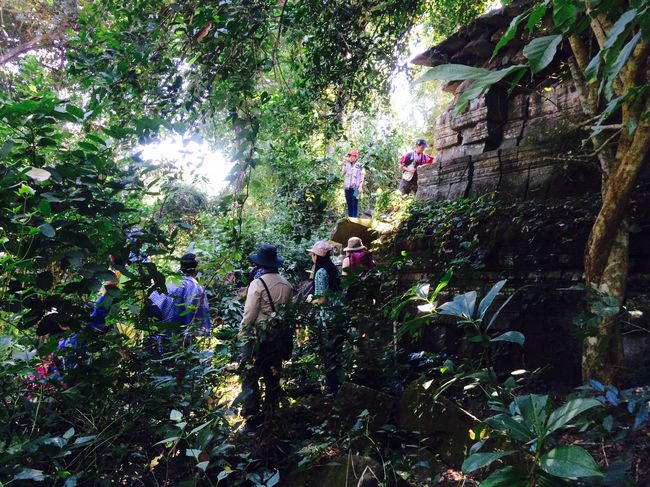
Koh Ker Field School – Torp Chey site visit, survey, and lecture (Credit: Dr. D. Kyle Latinis).
The Archaeological Unit (AU) at ISEAS – Yusof Ishak Institute (ISEAS) conducted an archaeological Field School from 2-22 December 2015 in Koh Ker, Cambodia. This was in collaboration with Cambodia’s APSARA Authority and was the third Field School conducted by AU in Cambodia.
There were a total of 12 students who participated in the Field School from a variety of East Asian countries including Cambodia; Indonesia; Laos; Vietnam; Philippines; Myanmar; Hong Kong; New Zealand; and Singapore.
The itinerary featured interactive site visits and informal on-site lectures. Hands-on training sessions took participants and staff through 2000 years of complex socio-political and economic evolution. Topics also included urbanisation, exchange dynamics, cultural influence, and multi-directional agency among pan-Asian networks. The pivotal points of analytical foci and departure spanned the famed Khmer polities of Funan (1st-6th centuries CE), Chenla (7th-8th centuries CE), and Angkor (9th-14th centuries CE).
The main event included coordinated archaeological and anthropological operations at multiple sites within the enigmatic 10th century Angkorian capital city of Koh Ker associated with the reign of Jayavarman IV. Participants lived on-site (in the forest) working with professional staff and local community members. They trained at three excavation locales to cover a diverse range of approaches, techniques and research questions. The results will provide valuable contributions to science, archaeology and history.
The final Field School leg in Singapore provided an important comparative component, added training opportunities, facilitated library access and allowed participants to finalise and present team projects.
The Field School was funded by the Ministry of Foreign Affairs, Singapore. Primary institutions included ISEAS and APSARA Authority. Supporting partners included the Ministry of Culture and Fine Arts, Cambodia; the Royal University of Fine Arts, Cambodia; The Royal Academy of Cambodia; the National Museum of Cambodia; the Hungarian Southeast Asian Research Institute; Ecole Francaise d’Extreme-Orient; and an extensive list of several other organisations and independent researchers who provided invaluable input, advice, opportunities and support.
Field School Director: Dr D. Kyle Latinis (ISEAS)
Field School Co-Director: Dr Ea Darith (APSARA Authority)
Field School Archaeologist and Operations Manager: Ms Foo Shu Tieng (ISEAS)
2015 Field School Administrative History
Announcement
Booklet (pdf, 1.23MB)
Call for applications (pdf)
Application Form (doc) (Deadline: 5PM (+8GMT), 21st Sept 2015)
Frequently Asked Questions (pdf)
Image Gallery

Archaeological Field School site visits and landscape archaeology training and historical ecology modelling at the ancient urban sites of Phnom Chisor and Angkor Borei, Cambodia. (Credit: Dr. Ea Darith)

Dr. D. Kyle Latinis (Field School Director) conducting surface survey, mapping, and landscape Archaeology training at Angkor Borei. (Credit: S. T. Foo)

Dr. Ea Darith (Field School Co-Director) discussing epigraphy and bar relief analysis at Angkor Wat. (Credit: S. T. Foo)

Art and architectural history training by Dr. Helene Njoto at Angkor Wat. (Credit: Dr. Ea Darith)

Field school students at Sambor Prei Kuk – site visit, applied research design, and site preservation training. (Credit: S. T. Foo)

Koh Ker Field School – Auger-coring and soil analysis training. (Credit: Dr. D. Kyle Latinis)

‘ASEAN-style’ group shot at Prasat Srayang, Koh Ker temple complex– site visits, survey and lectures led by the Hungarian Team. (Credit: S. T. Foo)

Excavation at Koh Ker 2 – recovering an intact early Khmer glazed jarlet. (Credit: S. T. Foo)

Mr. Aaron Kao conducting site and feature drawing training at Prasat Damrei, Koh Ker. (Credit: Dr. D. Kyle Latinis)

Local students and teachers visiting Koh Ker excavations as part of the interactive outreach initiatives. (Credit: Dr. D. Kyle Latinis)

Ethnographic and Ethnoarchaeological training with S. T. Foo at Kampong Chhnang traditional pottery making village. (Credit: Dr. D. Kyle Latinis)

Mr. Michael Ng briefing field school participants at the Archaeology Unit office, ISEAS – Yusof Ishak Institute, in Singapore (Credit: Dr. Ea Darith)

Field School students at ISEAS – Yusof Ishak institute. (Credit: Dr. Ea Darith)

Field school students giving a group presentation. (Credit: Loh Joo Yong)
General Information
The second session of the field school was held from 30th May to 17th July, 2013. The Royal Academy of Cambodia was this year’s partner institution for the Archaeological Field School. The curriculum included lectures, excavation, field trips, and laboratory training. Lectures incorporated broad topics—having to do with the historical, economic, and cultural impact of intra-Asian interactions—as well as specific instruction about the analysis and interpretation of Chinese and Southeast Asian ceramics as the most important source of data for the study of this topic. The teaching staff for the training program included prominent researchers from Cambodia, Singapore, and the United States.
In Singapore, students visited local museums and participated in a photography workshop. In Cambodia, students assisted in the excavation of an ancient kiln site at Cheung Ek, near the capital city of Phnom Penh.
Official announcement | FAQ | Information Booklet (2.66MB))
Field School of Archaeology Reading List (146kb) | Lecture Abstracts (108kb)
Participants
There were 37 applicants to this year’s field school session; 12 individuals were selected from the pool of applicants (2 from Cambodia, Indonesia, Singapore, Vietnam, and the United States; and 1 each from China and Japan). In addition, 2 Cambodian participants also attended the Cambodia segment of the field school.
Opening Sessions
The field school was officially opened by Dr. Ooi Kee Beng, the Deputy Director of the Institute of Southeast Asian Studies and Head of the Nalanda-Sriwijaya Centre on the 30th of July 2013 at Seminar Room III, in Singapore. Participants were welcomed by A/P John Miksic, the head of the Archaeology Unit.
The Cambodia segment was opened by Phon Kaseka, the head of the Archaeology department at the Royal Academy of Cambodia, on the 2nd of June, 2013.
Activities
In Singapore and Cambodia, the participants attended a series of lectures designed to provide them with a working knowledge of the background to the current state of Southeast Asian archaeology as well as on Southeast Asian pottery and kiln technology (see “Recorded Lecture: Ceramics, Technology, Trade, and Culture in Southeast Asia” by A/P Miksic). Members of the Archaeology Unit, such as Dr. John Miksic, Mr. Kwa Chong Guan, Dr. Goh Geok Yian, and Mr. Lim Chen Sian, all gave lectures.
In Cambodia, lectures were given by Mr. Phon Kaseka, Dr. Ang Choulean, Mr. Heng Piphal, Mr. Heng Sophady, and Mr. Siyonn Sophearith at the Royal Academy of Cambodia.
ISEAS Archaeology Unit (AU) staff, together with Cambodian colleagues, conducted field study trips to the National Museum of Cambodia, and to sites outside of Phnom Penh such as Udong (an ancient capital of Cambodia) and the Cheung Ek Genocide Center. The participants were also introduced to the Cheung Ek area by doing a walking survey of several ancient pottery kilns in the area, as well as a modern brick kiln.
Instructors at the Cheung Ek excavation included Dr. Chhay Rachna (APSARA Authority), Mr. Heng Piphal, Mr. Hoeung Sothearos, Dr. John Miksic, and Dr. Goh Geok Yian. The field school also provided an opportunity for the participants to understand the results of the excavation, as a public lecture was given by Mr. Phon Kaseka on the 17th of June, 2013.
Participant Presentations & Reports
The closing event of the field school consisted of 15-minute individual presentations by the students on their personal experiences, their insights about Inter-Asian Interactions gained from the field school, as well as the impact of the field school on the trajectories for their own future research and contribution to Southeast Asian archaeology and scholarship. Participants were also required to write a report on their own work performed at Cheung Ek.
Image Gallery

Overview
In 2009, the Institute of Southeast Asian Studies (Singapore) (renamed ISEAS – Yusof Ishak Institute in August 2015) established the Nalanda-Sriwijaya Centre (NSC) with the goal of reviving the ancient university of Nalanda as a center for culture and learning. The NSC conceived of an archaeological training program to support this project, which would bring ten students to Cambodia and Singapore (spending approximately two weeks in each country). The funding for the project is provided by the Singapore Ministry of Foreign Affairs. The teaching staff for the training program has included prominent researchers from Australia, Cambodia, Singapore, and the United States.
This program is meant to contribute to an increased understanding of the ancient and intimate links that have connected Asian countries, to emphasize the history of intra-Asian interactions over the past 2,000 years, and create a community of East Asia Summit (EAS) scholars. It will be through the participants that the training program will disseminate information on the Nalanda University project among the EAS countries’ citizens and governments.
Other institutions within the EAS that collaborated in this project include the Royal University of Fine Arts (RUFA), Authority for the Protection and Management of Angkor and the Region of Siem Reap (APSARA Authority), the Royal Academy of Cambodia, Sydney University, and the Australian National University.
The 18 East Asia Summit countries are: Australia, Brunei, Cambodia, China, India, Indonesia, Japan, Laos, Malaysia, Myanmar (Burma), New Zealand, the Philippines, Russia, Singapore, South Korea, Thailand, the United States, and Vietnam.
General Information
The first session of the field school, which was intially named the NSC Field School of Archaeology, was held from 9th January to 4th February, 2012. The curriculum included lectures, field trips, and laboratory training. Lectures incorporated broad topics—having to do with the historical, economic, and cultural impact of intra-Asian interactions—as well as specific instruction about the analysis and interpretation of Chinese and Southeast Asian ceramics as the most important source of data for the study of this topic. In Cambodia, students worked with Chinese and Khmer ceramics collected from recent fieldwork conducted in the Angkor area by a Cambodian-Australian team in the Robert Christie Centre, a laboratory built in Siem Reap by the University of Sydney. In Singapore, students visited local museums and helped to analyze Chinese and local ceramics excavated from 14th-century sites.
Official announcement | Information Booklet (download as PDF or read online as a flipbook)
NSC Field School of Archaeology Reading List (this was provided to participants as PDFs)
Participants
There were 57 applications to the field school; 10 individuals were selected, with 1 participant each from Cambodia, China, India, Indonesia, Myanmar, the Philippines, Russia, Singapore, Vietnam, and the United States. In addition, 4 local Cambodian participants also attended the Cambodia segment of the field school.
Opening Sessions & Visiting Dignitaries
The field school was officially opened by H.E. Khuon Khun-Neay, the Deputy Director General of APASARA Authority on the 10th of January 2012 at the Centre for Khmer Studies, in Siem Reap, Cambodia. Participants were welcomed by Dr. Michael Sullivan Director of CKS. Numerous Cambodian government officials, particularly from the fields of heritage management and archaeology, attended the opening ceremony. The wives of Singapore’s Minister of Foreign Affairs and the Ambassador to Cambodia of the Republic of Singapore also visited the workshop in the afternoon of the official opening. Dr. Miksic, a member of the board of the Center for Khmer Studies, gave the VIPs a guided tour of the Center.
The Singapore segment was opened by Ambassador Kesavapany, the Director of ISEAS, and Professor Prasenjit Duara, the Raffles Professor of Humanities, and Director at the Asia Research Institute, National University of Singapore, on the 25th of January, 2012.
Several members of the local press corps were in attendance and a resulting article on the field school was published in the Straits Times on the 30th of January, entitled “Building bridges to help dig deeper: New unit aims to bring together region’s young archaeologists.” Dou Hao / Zb Comma also released an article in Mandarin entitled “A New Experience in Archaeology, Bridging the Gaps in History.”
Activities
In Cambodia, the participants attended a series of lectures designed to provide them with a working knowledge of the background to the current state of Cambodian archaeology. These lectures were conducted by local Cambodian archaeologists: Dr. Ly Vanna, Dr. Ea Darith, Mr. Chhay Rachna, and H.E Tan Boun Suy, the Director of Angkor International Documentation for Research Centre of APSARA.
ISEAS Archaeology Unit (AU) staff, together with Cambodian colleagues, conducted field study trips to the Angkor Archaeological Park, the Preah Norodom Sihanouk Museum, and to sites outside of Angkor including Phnom Krom and Beng Melea. The participants also made a visit to the ISEAS AU sponsored excavations at Torp Chey, an 11th to 12th century kiln complex that was recently uncovered.
At the University of Sydney Robert Christie Centre, the participants spent a week learning about laboratory analysis and processing of archaeological ceramics. The students also took part in a field survey conducted by the University of Sydney’s Greater Angkor Project (GAP), and visited the future site of a major research and restoration project at the West Mebon. Instructors included Prof. Roland Fletcher, head of GAP; Dr. Martin Polkinghorne; Mr. Wayne Johnson; Dr. Dougald O’Reilly; and Ms. Linda McLaren.
In Singapore, classes were held to introduce the basics of archaeological artifact photography, artifact illustration, as well as laboratory processing of ceramic finds. Other classroom lessons include lectures on the archaeology of Singapore, inter-Asian interactions past and present, and the students were also introduced to museum management of artifacts, for which four museums and one archaeological site were visited. Prof. Kwa Chong Guan gave a lecture on museology at the NUS Museum. The field school also provided an opportunity for the participants to understand the applications of the past to today’s political agendas as the ISEAS NSC organized a large public seminar titled “An Afternoon with Zheng He” involving the participants; over a hundred people attended the seminar as the subject matter was quite popular. The documentary “Junk History” was screened, followed by a lively discussion between the organizers, audience and the field school participants.
Participant Presentations & Reports
The closing event of the field school consisted of 15-minute individual presentations by the students on their personal experiences, their insights about Inter-Asian Interactions gained from the field school, as well as the impact of the field school on the trajectories for their own future research and contribution to Southeast Asian archaeology and scholarship. Each participant submitted two separate written papers on interactions within Asia, based on their experiences in Cambodia and Singapore, as reflected in history and archaeology.
Image Gallery
NSC AU Archaeology Report Series
The following authors have kindly granted the NSC permission to distribute online the following research reports for non-commercial purposes. If you would like to use the information or ideas presented in the report(s) below, please acknowledge the source through the use of proper academic citations.
- Mathers, W. M., and Flecker, M. (eds.) (1997). Archaeological Recovery of the Java Sea Wreck. Maryland: Pacific Sea Resources, Inc. (6.51MB)
- Ward, Jayne, Kotitsa, Zoi, and D’Angelo, Alessandra (eds.). (2004). The Belitung Wreck: Sunken Treasures from Tang China. Seabed Explorations New Zealand Ltd.
Contributors
William M Mathers, a history major at Yale, served as a US Navy Diving and Salvage officer in Vietnam. After the military, he worked as a marine salvage master in the South Asia. In 1975, he became the operations partner in a marine construction firm building oil terminals, commercial docks and related civil works around the world. Ten years later, he formed PSR to undertake commercial marine archaeological projects in water depths up to 500 feet. His marine experience also includes the ownership and design of ocean-going sailing and power catamarans.
Dr Michael Flecker has excavated over a dozen shipwrecks throughout Southeast Asia over the past 25 years. They date from the 9th to the 19th century and derive from China, Southeast Asia, Arabia and Europe. Flecker consequently specialises in ancient Asian ship construction and trade. For details of these shipwrecks and Flecker’s publications see www.maritime-explorations.com.
Prof. John Miksic has kindly granted the Archaeology Unit permission to disseminate an Indonesian translation of W. Marschall’s (1968) Metallurgie Und Frühe Besiedlungsgeschichte Indonesiens for non-commercial research purposes. The translation by Satyawati Suleiman from the original German to Indonesian was privately commissioned by Prof. Miksic. If you would like to use the information or ideas presented in the works below, please acknowledge the source through the use of proper academic citations.
[Prof. John Miksic telah memberikan izin kepada Satuan Arkeologi untuk menyebarkan sebuah translasi dalam bahasa Indonesia dari bahasa German, yaitu “Metallurgie Und Frühe Besiedlungsgeschichte Indonesiens” yang ditulis oleh W. Marschall (yang pada awalnya diterbit pada tahun 1968), untuk tujuan penelitian yang non-komersial. Prof. Miksic dulu meminta Satyawati Suleiman untuk menerjemahkan karya tersebut secara pribadi. Jika Anda ingin menggunakan informasi atau ide-ide yang disampaikan oleh karya tersebut, tolong kutipkan sumbernya.]
- De Loos, D. (1889). Gesteenten En Mineralen van Nederlandsch Oost-Indie Vol. II: Diamant en Edele Metalen. Haarlem: De Erven Loosjes. (In Dutch) (3.95MB PDF)
- Marschall, W. (1980s). Metalurgi dan Sejarah Kuna di Indonesia / Metallurgie Und Frühe Besiedlungsgeschichte Indonesiens (S. Suleiman, Trans.). Ethnologica Neue Folge Band 4. E. J. Brill: Köln. (In Indonesian; Original German work published in 1968) (15.2MB PDF)
About Satyawati Suleiman
Satyawati Suleiman was an art historian and Archaeologist who became the Director of the National Research Center for Archaeology (Indonesia) between 1973-1977. She was very influential in developing the study of ancient Sumatra, and in particular, of Sriwijaya (the 7th-13th century empire based in Sumatra). For more information, please see:
Wolters, O. W. (1988). “In Memoriam: Satyawati Suleiman, 1920-1988.” Indonesia 46 (Oct.): 123-125. http://cip.cornell.edu/seap.indo/1107010943.
[Satyawati Suleiman adalah seorang sejarawan seni dan Arkeolog yang menjadi Direktur Pusat Penelitian Arkeologi Nasional (Indonesia) diantara tahun 1973 sampai 1977. Beliau dikenali sebagai seseorang yang telah mengarahkan dan mengembangkan kegiatan penelitian tentang Sumatera zaman dahulu, dan khususnya, tentang Sriwijaya (sebuah kerajaan yang berbasis di Sumatera diantara abad ke-7 dan ke-13). Untuk informasi lebih lanjut silahkan baca artikel yang diatas.]
The following authors have kindly deposited these following works with us for online dissemination. If you would like to use the information or ideas presented in the works below, please acknowledge the source through the use of proper academic citations.
- Ardika, I. W. (1991.) Archaeological Research in Northeastern Bali Indonesia. Unpublished doctoral dissertation, Australian National University. (6.52MB PDF)
Abstract:
Archaeological discoveries indicate that the coastal areas around the villages of Julah, Pacung and Sembiran in northeastern Bali have been involved in long distance trade since at least 2000 years ago. The discovery of Indian sherds, including Rouletted Ware, a rim sherd of Arikamedu type 10, a sherd inscribed with Kharoshthi characters and hundreds of glass beads suggest that contacts between India and Bali were already occurring at this time. The Indian traders might have stopped at Sembiran while trading for spices and aromatic woods from the eastern part of the Indonesian archipelago. Sembiran probably functioned as an ancient port located on a major spice trade route.
Sembiran might have also functioned as a manufacturing site, as suggested by the finding of a fragment of a mould for impressing decoration into wax during the production of Pejeng-type bronze drum.
Inscriptional data from the 10th to 12th centuries indicate that Julah (including Sembiran?) had developed as “a gateway community” into northeastern Bali by this time. There was a market in Julah, and also a guild or community of foreign traders. Regulations are mentioned in the inscriptions for those who lived in this settlement, which was plundered at least once and the villagers captured, killed, or dispersed. It is not clear why Julah was eventually abandoned as a port, but rapid alluvial sedimentation and poor security could have been major reasons for its abandonment.
This thesis describes the excavated archaeological data from sites in the vicinity of Julah, most of which date to the first centiry AD, later deposits are present in some trenches. Appendices at the end of this thesis describe the result of pottery and soil analysis, glazed trade ceramics, and the contents of the inscriptions of the 10th to 12th centuries.
- Edwards McKinnon, E. (1984). Kota Cina: Its Context and Meaning in the Trade of Southeast Asia in the Twelfth to Fourteenth Centuries. Unpublished doctoral dissertation, Cornell University. (23.9MB PDF)
Abstract:
Over the past three-quarters of a century, the search for the lost Malay kingdom of Srivijaya has evolved through the study of epigraphy, historical sources, particularly Chinese, and art historical artifacts, to geographical survey and analysis of archaeological materials recovered by excavation. These developments have led to a more complete understanding of both human and natural resources and the environment of the area in which they existed.
Little or nothing was known of Srivijayan period archaeological sites in northeastern Sumatra, an area which historical sources suggest played an important role in east-west maritime trade during the first and early second millennium A.D. Excavation undertaken at Kota Cina thus provides data which help to shed light on cultural and economic in this area during the twelfth and fourteenth centuries, a period in which the name Srivijaya fades from historical sources.
Analysis of ceramic materials, both low fired earthenware and high fired imported stonewares, has proved useful, both as an aid to dating and for establishing physical trading and cultural relationships overseas. The high quality of much of the imported stoneware suggests a high level of prosperity among the ancient inhabitants of the site and infers important connections with the interior, a rich source of natural products such as benzoin, camphor and possibly gold.
Analysis of excavated materials also indicates important connections with both south India and south China and suggests the presence of Tamil and south Chinese communities at the site. The presence of the former may account for the occurrence of Dravidian sept names among the Karo merga Sembiring community in the mountainous hinterland. The existence of a Chinese community in northeastern Sumatra occurs at a time that historical sources indicate increased Chinese maritime activity in the area.
- Miksic, J. N. (1979). Archaeology, Trade and Society in Northeast Sumatra. Unpublished doctoral dissertation, Cornell University. (30.6MB PDF)
Abstract:
“By the first or second century A. D. a set of integrated political and economic institutions existed in many ports on a network of maritime trade routes which connected coasts of east Africa, western Asia, India, and Southeast Asia. China independently evolved similar procedures and institutions in her dealings with nomadic groups along with her inland frontiers, and when in about the fifth century A. D. the ports in south China joined in the commerce of the Nanhai (South Seas), China used many of these institutions to regulate this commerce as well. Merchants from the West would have found practices in the Chinese ports to be little different from those already familiar from visiting other ports in the network. This system was still functioning when the Portuguese and other Europeans began trading in the Indian Ocean in the sixteenth century.
Indonesians probably participated in the Indian Ocean network at a very early period. Indonesian products such as camphor, benzoin, cloves, and pepper were important commodities in Indian Ocean markets. Control over foreign trade could provide enormous wealth for rulers, and historical evidence shows that members of elites in maritime Southeast Asia and elsewhere were deeply concerned with acquiring wealth and exotic objects to use as means of maintaining political power.
Historical reconstructions indicate that Sumatran emporia were important commercial centers by the early first millennium A. D. The sources of marketable Sumatran produce lay in the highlands, but there is little historical information regarding the routes by which the commodities were brought to the coastal emporia, and the arrangements between hinterland producers and lowland rulers which governed this internal traffic. This lack of information is to some extent the result of policies which lowland rulers pursued, in their attempt to interpose themselves between producers and foreign merchants.
Archaeological research, still in the initial stage in Sumatra, can contribute to the study of the old commercial system in two ways: by discovering and examining sites of coastal emporia, and by tracing the cultural, political and economic relationships between coastal emporia and their hinterlands. The second goal has not yet been attempted in Southeast Asia. Studies of hinterland-lowland relationships can contribute significantly to reconstructions of pre-colonial Indonesian society, and the role of long-distance trade in the development of Indonesian civilization.
In this study, which focuses on the Deli River valley of northeast Sumatra, [the author uses] historical, geomorphological and archaeological information to discover places which were important in pre-colonial trade in imported objects, and the extent to which the “gateway city” hypothesis is useful in understanding early Sumatran economic processes. [The author] also make some suggestions for future research in Sumatra to test hypotheses formed on the basis of this data, and consider briefly some ways in which the study of Sumatran civilization can contribute to the broader questions of the role of long-distance trade in the evolution of civilized societies generally.
- Mundardjito. (1993). Pertimbangan Ekologi Dalam Penempatan Situs Masa Hindu-Buda di Daerah Yogyakarta: Kajian Arkeologi-Ruang Skala Makro. Unpublished doctoral dissertation. Universitas Indonesia. (9.46MB PDF)
- English translation of thesis summary by S. T. Foo (140KB PDF)
Abstract (written by S. T. Foo):
How might people choose certain plots of land for the location of a temple building during the Hindu-Buddhist period in central Java? Would some of these decisions be guided by ecological considerations? Ancient Indian texts, such as the Mānasāra-Śilpaśāstra and Śilpa Prakaśa, which outlined some guidelines for temple construction in India, for example, suggested that land and water potential were important considerations; however, were the builders following such guidelines in central Java? Mundardjito’s regional research, which focuses on the Bantul and Sleman districts of Central Java, looks at whether there are correlations between temple site distribution and natural resource variables (such as terrain gradient, landforms, soil types, and rock types) as well as land potential variables (such as effective soil depth, groundwater availability, and the distance to rivers and/or springs). His research goes on to look at what kinds of variable clusters and site groupings would be produced on the basis of ecological variables alone.
Please note that the indonesian PDF only contains the Summary, Chapter 1, Chapter 7, and segments of the appendix. The AU has translated the summary into English.
Contributors
Dr. I Wayan Ardika is a senior lecturer at Udayana University’s Faculty of Letters. He has a bachelor’s degree in Archeology from Udayana University and a doctoral degree in Prehistory and Anthropology from Australian National University. He has served as the dean of the Faculty of Letters at Udayana since 2003. He has also served as the dean of the Faculty of Tourism (1999-2001), head of postgraduate program on tourism (2001-2003) and has served in the post-graduate program on cultural studies (head, 2001-2003; secretary, 1996-1999).
Dr. E. Edwards McKinnon is an Associate Fellow at the Nalanda-Sriwijaya Centre, ISEAS – Yusof-Ishak Institute. He has received a PhD. and an M. A. from Cornell University and is a Fellow of the Royal Asiatic Society, London. A long term resident in Indonesia, he is concerned with cultural heritage management and conservation and has written on art historical and archaeological subjects relating to Sumatra, west Java and Kalimantan, in particular archaeological ceramics, Buddhist imagery in Kutei and early Islamic tombs in Aceh. His current research interests are mediaeval south Indian relationships with Sumatra, the pre-sultanate archaeology of Aceh and arrival of Islam as well as the historical impact of seismic events in the Aceh region.
Dr. John Miksic is an Associate Senior Fellow at the Nalanda-Sriwijaya Centre, ISEAS – Yusof-Ishak Institute. He is also Associate Professor at the Department of Southeast Asian Studies, National University of Singapore. As a student Dr. Miksic joined archaeological expeditions to northern Canada and Honduras, but over the last 40 years he has been based in Southeast Asia, conducting archaeological and historical investigations in Singapore, Malaysia, Thailand, Indonesia, Burma and Cambodia. He is a widely-published author with key works including: Archaeological research on the “Forbidden Hill” of Singapore: excavations at Fort Canning (1985); Borobudur: golden tales of the Buddhas (1990); Old Javanese Gold (2010); Earthenware in Southeast Asia (2003); Early Singapore 1300s-1819: Evidence in maps, texts and artefacts (ed. with Cheryl-Ann Low) (2004); and the Historical Dictionary of Ancient Southeast Asia (2007). His interests include early Buddhist artifacts and monuments; ceramics of China and Southeast Asia; gold; urbanization; and maritime trade.”
Prof. Dr. Mundardjito is currently Guru Besar Luar Biasa at the Department of Archaeology, Faculty of Humanities, University of Indonesia. He was one of the founding members of Ikatan Ahli Arkeologi Indonesia (IAAI) in 1976 and has also written important works on Borobudur and its vicinity and regarding Trowulan and the Majapahit kingdom. Specializing in landscape and ecological archaeology, he was also involved in the implementation of an Indonesian Archaeological Code of Ethics, which was passed by the IAAI Congress in 2005. He received the Achmad Bakrie award for Social Thinker of the Year in 2014.
NSC Lecture Series
1819 and Before: Singapore’s Pasts
In commemoration of the bicentennial of Stamford Raffles’s establishment of an East India Company settlement on Singapore in 1819, the Nalanda-Sriwijaya Centre (NSC), at the ISEAS-Yusof Ishak Institute, has organised a special lecture series entitled ‘1819 and Before: Singapore’s Pasts’. This seminar series aims to introduce the premodern and early history of Singapore, and to locate it in the broader region.
- Why Was There No Singapore Before Raffles? by Mr Kwa Chong Guan (18 July 2018)
- The Orang Laut and the Realm of the Straits (Negara Selat) by Prof Leonard Andaya (25 July 2018)
The Khmer Empire and Its Road Network by Dr. Ea Darith (12 Feb 2015)
Dr. Ea Darith gives an overview of the development of the Khmer Empire and The Living Angkor Road Project (LARP), a Cambodian–Thai joint research project. LARP has been conducting research along the said road since 2005. The team has already identified 32 ancient bridges, 385 water structures, 134 temples, 17 rest houses, 8 hospitals, a number of iron smelting sites, hundreds of stoneware ceramic kilns, and many habitation sites.
The Tombstones of Lamreh (Ancient Lamri) by Dr. E. Edwards McKinnon (4 March 2015)
Dr. E. Edwards Mckinnon looks into the prevalence and tradition of Islamic tombstones in Lamreh, Aceh, Indonesia. He suggests that two distinct types of tomb stones–the plain proto-batu Aceh and a distinct so-called plang pleng tradition–may help in understanding the arrival of Islam in the Aceh region.
NSC AU Lecture Series
Pots and how they are made in Southeast Asia by Dr. Leedom Lefferts (13th April, 2012)
Dr. Leedom Lefferts and Louise Allison Cort (Curator, Asian Ceramics, Freer and Sackler Galleries, Smithsonian Institution) conducted an intensive study of the indigenous production of earthenware and stoneware pottery by surveying over 200 locations in mainland Southeast Asia (including Southern Yunnan, China, but excluding Myanmar (Burma). They preliminarily charted six types of earthenware and two types of stoneware production across the region and have presented and published over a dozen papers on the subject (some of which are available in digitized format here).
This presentation summarizes their research findings and emphasizes three issues: the nature of the research as “ethno-archaeological method”; “embodied” behavior as indicative of cultural continuity and change, vis-à-vis pot form and decoration (and the difficulties associated with making archaeological discoveries in this domain); and the impact of these findings on the understandings of accepted Southeast Asian linguistic, political, and socio-organizational mapped boundaries. It is through their research findings that they propose a history of technological production behaviors that will begin to provide a nuanced understanding of contact and migration across the diverse landscape that is mainland Southeast Asia.
Same Same, but Different: The Rock Art of Southeast Asia by Noel Hidalgo Tan (31st August, 2012)
Rock art – paintings or carvings on rock, and other similar markings in the landscape – is not immediately associated with Southeast Asia. Because of its perceived rarity and obscurity, it remains one of the least understood archaeological phenomena in the region. Is there much rock art, if at all, in Southeast Asia? Where are they located? What can we learn from them?
Ancient Fansur, Aceh’s ‘Atlantis’: The Case for Lhok Pancu / Indrapurwa by Dr. E. Edwards McKinnon (3rd May, 2013)
Following recent seismological and archaeological research, there is increasing evidence to suggest that the long-lost site of ancient Fansur, a toponym often associated with the Barus region, may be found in the geographically strategically located bay of Pancu, a short distance west of the modern city of Banda Aceh (which is located on the island of Sumatra in Indonesia).
NSC Archaeological Field School Lectures
Ceramics, Technology, Trade, and Culture in Southeast Asia by Dr. John Miksic (30th May, 2013)
Dr. John Miksic gives a general overview to students of how the study of ceramics in Southeast Asia can give insight into production techniques, technological advancements, trade, and culture. This lecture was given in preparation for the students’ involvement with the Cheung Ek Excavation in June 2013, which was led by Mr. Phon Kaseka of the Royal Academy of Cambodia.
Public Talks
Guerilla Archaeologists and the Singapore Story (part 1, part 2 – courtesy of the NUS Museum) by Dr. John Miksic (12 April, 2012)
Most people think Singapore and archaeology are boring subjects, but the combination of the two can be exciting. Since Singapore has no laws covering archaeology, it is possible and sometimes necessary to go about the exploration for new sites in unorthodox ways. The term “underground” can mean something different in Singapore than it does in normal archaeological contexts! In this talk Assoc. Prof. John Miksic will provide an account of the history of archaeology in Singapore since 1984, and its connection with museums.
Raffles, Archaeology, and the British in Indonesia by Dr. John Miksic (24th November, 2012)
During his tenure as lieutenant governor of Java and as governor of Bencoolen, Raffles contributed much to the study of ancient Southeast Asia. This talk focuses on Raffles’ career and his role in fostering the study of the past before archaeology existed, as well as on what we have learned about the British in Sumatra from excavations at York Fort in the 1980s.
What Did Raffles See in Singapore? by Mr. Lim Chen Sian (2nd February, 2013)
Apart from an idyllic fishing village, what greeted Raffles, Farquhar and the early European pioneers when they landed in Singapore? Examining the few extant historical sources and clues from archaeological remains, this talk investigates what Singapore was like before and after Raffles’ arrival.
A Brief History of Singapore Archaeology, 1984-2013 by Dr. John Miksic (5th November, 2013)
This presentation was given during the NUS Press’s launch event for Dr. John Miksic’s book “Singapore and the Silk Road of the Sea, 1300-1800? at the National Museum of Singapore.
Potsherds, Texts, and Singapore’s Role in Southeast Asian Maritime Culture by Dr. John Miksic (19th December, 2013)
Archaeological research since 1984 has shown that the (Sejarah Melayu (SM))’s depiction of precolonial Singapore was not completely false. Singapore was not the first great Malay port, but for a period of 300 years, from 1300 to 1600, it was a prosperous settlement with local industries. Archaeology shows that Singapore had three roles in the 14th through 16th centuries: a regional centre of economic activity; a link between the Indian Ocean, the South China Sea, and the Java Sea; and a part of a larger empire. Temasek/Singapura successfully balanced these roles until 1600, when the island was almost completely abandoned. In “Singapore and the Silk Road of the Sea,” Dr John Miksic will tell this story, and also show how the revival of the ancient port in the 19th century was based on belief in the truthfulness of the SM.



